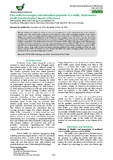Free radical scavenging and antioxidant properties of a truffle, Kalaharituber pfeilii found in Kalahari deserts of Botswana

View/
Date
2015Author
Chaturvedi, P.
Khare, K.B.
Kwape, T.
Makholwa, K.
Publisher
Int.J.Bioassays, http://www.ijbio.com/index.php/ijbType
Published ArticleMetadata
Show full item recordAbstract
Natural anti-oxidants are the good source for scavenging excess of free radicals generated in the body after oxidative stress. The present study is aimed at in vitro evaluation of free radical scavenging potentials of two extracts prepared from samples of a truffle, Kalaharituber pfeilii collected from Kalahari desert in Botswana. These are water extract (WTE) and methanol extract (MTE).First of all, DPPH-TLC-Semi quantitative assay was used to assess the anti-oxidant properties. This experiment showed that at lower concentration, WTE showed better results than MTE and gallic acid. But at higher concentration, 90% inhibition was noted. Five in vitro system; DPPH, ABTS, Hydrogen peroxide, reducing power and Nitric Oxide, were employed to measure the radical scavenging potentials of WTE and MTE. Phenol content of WTE and MTE were determined and it was found that WTE had more phenol content (549mg GAE/g) as compared to MTE. Both the extracts of the truffle showed concentration dependent significant free radical scavenging in all the five assay systems employed. WTE was found to be more effective than MTE. Free radical scavenging activities and anti-oxidant potentials are due to possession of high phenol content.
